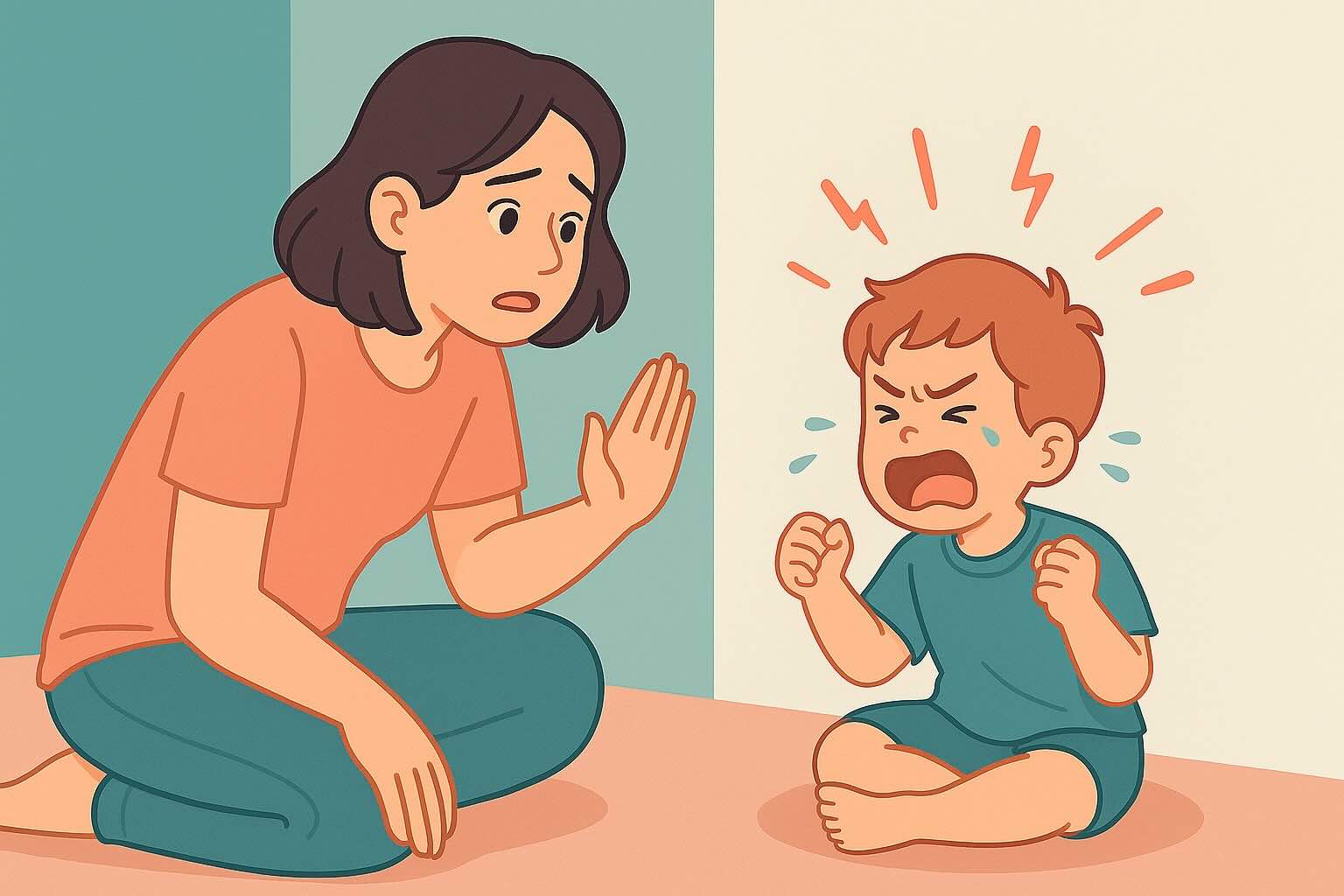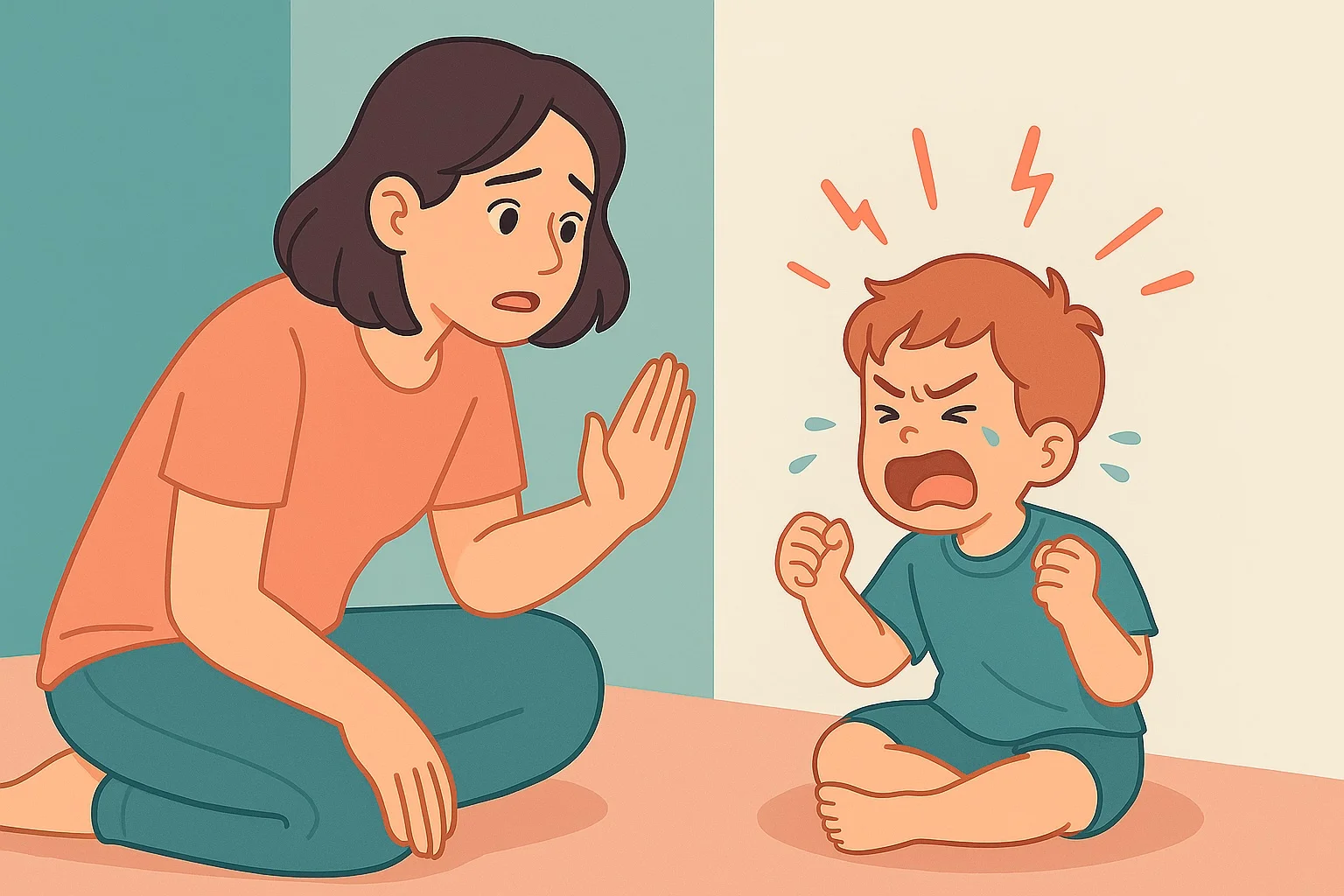How to Stop Toddler Tantrums: 5 Proven Techniques That Work in 2 Weeks


If you're reading this while hiding in the bathroom after your toddler's third meltdown today, take a deep breath. You're not alone, and more importantly, you're not failing as a parent. While only 20% of toddlers have daily tantrums, intense emotional outbursts are a completely normal part of development for most children between 18 months and 4 years.
This comprehensive guide provides evidence-based strategies from child development research, tested by real parents. No more guessing, no more guilt—just practical tools with realistic expectations about what actually works. For parents struggling with power struggles beyond tantrums, you might also find our managing power struggles guide helpful for understanding the broader dynamic. If bedtime tantrums are your biggest challenge, our night tantrums bedtime guide provides specialized strategies for sleep-related meltdowns.
For specific situations, also check out our public tantrum survival guide for grocery stores and restaurants, our age-specific tantrum strategies for 18-month vs 2-year-old differences, and our screen time meltdowns guide for device-related emotional outbursts.
What You'll Learn in This Guide
- The Real Science - Why your toddler's brain literally cannot control emotions yet
- Honest Statistics - Realistic data about tantrum frequency, duration, and patterns
- The 5-Step Response Method - Exactly what to say and do during meltdowns
- Prevention Strategies - How to reduce tantrums significantly with simple changes
- Age-Specific Approaches - Different techniques for 18-month vs 2-year-olds
- When to Seek Help - Red flags that indicate professional support is needed
- Real Parent Success Stories - How other families transformed their daily challenges
Estimated reading time: 10 minutes
Why Toddlers Have Tantrums: The Brain Science Every Parent Should Know
Your Toddler's Brain: Why Emotional Control Is Impossible
Your toddler's brain is like a sports car with bicycle brakes. The emotional center (amygdala) is fully operational and firing on all cylinders, but the prefrontal cortex—responsible for emotional regulation and impulse control—won't be fully developed until their mid-twenties.
This means your child literally cannot control their emotions the way adults can. When they're screaming because you gave them the blue cup instead of the red one, they're experiencing genuine distress that feels overwhelming to their developing nervous system.
Important note: While this brain development model is useful for understanding emotional challenges, modern neuroscience recognizes that the brain works as integrated networks rather than separate "emotional" and "rational" regions. The key point remains: emotional regulation skills are still developing throughout childhood.
When Toddler Tantrums Peak and Why (18 Months to 4 Years)
During this period, several developmental factors collide:
- Language limitations: They have big feelings but limited words to express them
- Growing independence: They want control but lack the skills to manage it
- Cognitive development: They understand more than they can process or communicate
- Physical needs: Hunger, tiredness, and overstimulation hit harder and faster
- Emotional intensity: When overwhelmed, emotional regulation systems become less effective
For children whose tantrums are particularly intense or frequent, understanding your child's underlying temperament can be crucial. Our spirited child guide provides specialized strategies for high-intensity personalities, while our sensitive child guide offers approaches for children who become easily overwhelmed.
Normal Tantrum Signs vs. When to Worry About Your Toddler
Normal tantrum behaviors:
- Crying, screaming, throwing themselves on the floor
- Hitting, kicking, or throwing objects (toward objects, not people)
- Lasting 0.5-5 minutes (75% of tantrums last 5 minutes or less)
- Ending when the child is comforted, needs are met, or they exhaust themselves
Research-based tantrum statistics:
- Frequency: Only 20% of 2-year-olds have daily tantrums; 50% have tantrums 2-3 times per week
- Duration: Most tantrums (modal average) last 0.5-1 minute, though they feel much longer
- Peak age: 18-24 months, declining significantly by age 4
- Individual variation: Some children naturally have more intense emotional responses
Concerning behaviors that warrant professional consultation:
- Tantrums lasting longer than 15 minutes regularly
- More than 5 tantrums per day consistently for children over 2 years
- Self-harm during tantrums (head banging, hitting themselves repeatedly)
- Aggressive behavior toward others that doesn't improve with intervention
- Tantrums that worsen or increase in frequency after age 4
- Complete inability to be consoled for extended periods
- Inability to calm down without extensive adult intervention
- Property destruction during tantrums
- Persistent tantrums beyond age 5
How to Respond to Toddler Tantrums: 5-Step Method That Works
This evidence-based framework from developmental psychology research provides structure when implemented consistently. Each step builds on the previous one, creating a calm, predictable response that helps your child learn emotional regulation over time.
Step 1: Stay Calm During Toddler Tantrums (Get on Their Level)
Your first priority is your own emotional regulation. Take a deep breath, lower your voice, and physically get down to your child's eye level. This signals safety and connection, not threat.
What to say:
- "I'm right here with you."
- "You're safe."
- "I can see you're having big feelings."
What NOT to say:
- "Stop crying right now!"
- "You're being dramatic."
- "Big boys/girls don't cry."
Step 2: Label Your Toddler's Emotions ("Name It to Tame It")
Dr. Dan Siegel's research on affect labeling shows that naming emotions helps activate prefrontal cortex regions while reducing amygdala reactivity. This neurobiological process literally helps calm the nervous system, though it works better as children develop language skills.
How to implement:
- "I see you're really angry that we have to leave the park."
- "You're frustrated because your tower fell down."
- "It's hard when you can't have the toy right now."
- "Your body is telling you that you're disappointed."
Step 3: Validate Toddler Feelings Without Giving In to Demands
Validation is NOT the same as giving in to demands. You're acknowledging their feelings while maintaining necessary boundaries.
Validation scripts:
- "It makes sense that you're upset about this."
- "I would be disappointed too if I had to stop playing."
- "Your feelings are important to me."
Maintain the boundary:
- "AND we still need to leave the park."
- "AND we still can't have candy before dinner."
- "AND we still need to clean up our toys."
Step 4: Wait for the Tantrum Storm to Pass (Don't Reason Yet)
Do NOT try to reason, teach, or solve problems during peak emotional intensity. Your job is to be a calm, safe presence while they process intense feelings.
During this phase:
- Stay nearby (don't abandon them)
- Keep your voice low and calm
- Offer comfort when they're ready to receive it
- Ensure their physical safety without restraining unnecessarily
If your child's tantrums happen frequently around bedtime, you may also want to explore our bedtime battles guide to address sleep-related emotional overwhelm.
Step 5: Problem-Solve Together After the Tantrum Ends
Once the emotional intensity has decreased (you'll see it in their body language and breathing), THEN you can engage their developing reasoning skills.
Problem-solving questions:
- "What could we do differently next time?"
- "How can I help you when you feel this way?"
- "Would you like to try again?"
7 Proven Ways to Prevent Toddler Tantrums Before They Start
The HALT Method: Check These 4 Basic Needs to Prevent Tantrums
Before any transition or potentially challenging situation, check if your child is:
- Hungry: Keep healthy snacks readily available
- Angry: Address underlying frustrations before they escalate
- Lonely: Ensure adequate connection and positive attention
- Tired: Maintain consistent sleep schedules and recognize fatigue signs
Research support: While the HALT framework is clinically useful, specific research on its effectiveness for toddler tantrum prevention is limited. However, studies consistently show that addressing basic needs reduces behavioral problems in young children.
Environmental Setup for Success
Create predictable routines:
- Same wake-up and bedtime sequences
- Consistent meal and snack times
- Predictable transitions with 5-10 minute warnings
- Visual schedules for daily activities (pictures help pre-readers)
Reduce overstimulation:
- Limit screen time before challenging activities (for more help with this, see our screen time meltdowns guide)
- Create quiet spaces for emotional regulation
- Use soft lighting and calming music during wind-down times
- Remove overwhelming choices (offer 2-3 options maximum)
Proactive Emotional Regulation Teaching
During calm moments:
- Read books about emotions and feelings
- Practice deep breathing exercises ("smell the flower, blow out the candle")
- Use emotion identification games and feeling faces
- Model your own emotional regulation out loud
Teach age-appropriate coping strategies:
- Count to 10 together (or as high as they can)
- Use a designated calm-down corner with comfort items
- Practice "balloon breathing" or "bunny breaths"
- Create a feelings wheel or emotion cards for identification
Age-Specific Tantrum Strategies
18-24 Months: The "Pre-Verbal" Phase
At this age, tantrums are primarily about communication frustration and overwhelming physical needs.
Strategies that work:
- Use simple, concrete language (2-4 words)
- Offer lots of physical comfort and presence
- Redirect to sensory activities (water play, music, movement)
- Keep routines very predictable and consistent
- Use sign language, picture cards, or gestures to support communication
Common triggers:
- Inability to communicate specific needs or wants
- Overstimulation from environments or activities
- Hunger, tiredness, or discomfort
- Wanting something they can see but can't have
- Transitions between preferred activities
2-3 Years: The "Assertion" Phase
This is peak tantrum time. Your child is asserting independence but lacks the developmental skills to manage complex emotions and situations.
Strategies that work:
- Offer limited choices ("Would you like to wear the red shirt or blue shirt?")
- Use "when/then" statements ("When you put on your shoes, then we can go to the park")
- Create "yes" spaces where they have appropriate control
- Use visual timers for transitions and turn-taking
- Acknowledge their desire for autonomy while maintaining safety
Common triggers:
- Wanting control over their environment and decisions
- Difficulty with transitions between activities
- Feeling rushed or pressured by adult schedules
- Overstimulation in public places or social situations
- Testing boundaries and exploring cause-and-effect
3-4 Years: The "Reasoning" Phase
Your child can understand more complex explanations but still struggles significantly with emotional regulation and impulse control.
Strategies that work:
- Explain simple cause and effect relationships
- Use emotion coaching during calm moments
- Create collaborative problem-solving opportunities
- Set clear expectations with logical consequences
- Practice emotional regulation skills during non-stressful times
Common triggers:
- Frustration with tasks that exceed their current abilities
- Social challenges and peer conflicts
- Feeling misunderstood or not listened to
- Testing boundaries and adult reactions
- Developmental challenges with new skills
Realistic Expectations About Intervention Success
What Research Actually Shows
Tantrum reduction expectations:
- Most families see some improvement within 2-4 weeks of consistent approach
- Significant reduction (50%+ decrease) occurs for about 60-70% of families
- Complete elimination of tantrums is unrealistic and not developmentally appropriate
- Individual variation is enormous—some children respond faster, others need longer
Important caveats:
- High-intensity, sensitive children may need 6-8 weeks to show improvement
- Success often means shorter duration and faster recovery, not absence of tantrums
- Consistency across all caregivers is crucial for effectiveness
- Developmental regressions (illness, life changes) can temporarily increase tantrums
When Interventions Don't Work as Expected
After 4-6 weeks of consistent implementation:
- Consider your child's individual temperament and sensory needs
- Evaluate environmental factors, schedules, and family stress
- Consult pediatrician about potential developmental or medical issues
- Consider occupational therapy evaluation for sensory processing
- Remember that some children need specialized approaches
When to Seek Professional Help
Red Flags That Warrant Professional Consultation
- Tantrums lasting longer than 15 minutes regularly (not just occasionally)
- More than 5 tantrums per day consistently for children over 24 months
- Self-harm during tantrums (head banging, hitting themselves, breath-holding)
- Aggression toward others that doesn't improve with consistent intervention
- Tantrums that worsen or increase in frequency after age 4
- Inability to be consoled for extended periods without specific intervention
- Developmental regression (loss of previously acquired skills)
- Property destruction during tantrums
- Family functioning significantly impacted for more than 2 months
- Persistent tantrums beyond age 5
Types of Professional Support Available
Child psychologists specialize in behavioral strategies and emotional regulation development Occupational therapists help with sensory processing issues and environmental modifications (particularly helpful for sensitive children who may be more reactive to environmental triggers) Pediatricians can rule out medical causes and provide developmental perspective Early intervention specialists work specifically with children under 3 and their families Family therapists assist with family dynamics and parenting stress
How to Find Qualified Help
- Start with your pediatrician for appropriate referrals
- Contact your insurance company for covered providers in your area
- Look for specialists with specific experience in toddler behavior and development
- Ask about their therapeutic approach to ensure alignment with your family values
- Consider university training clinics for evidence-based approaches
Real-Life Success Stories
Sarah's Story: The Morning Routine Transformation
"Emma used to have massive meltdowns every morning when getting dressed. Once I understood she was seeking control and choice, I started offering two outfit options the night before and let her help pick them out. We also added a visual schedule with pictures. The tantrums dropped by about 70% within three weeks. Now she feels empowered and our mornings are generally peaceful, though we still have occasional rough days."
Mike's Story: The Grocery Store Strategy
"My 2-year-old Jake would have epic meltdowns at the grocery store. I started bringing snacks, a special shopping list with pictures of items for him to find, and giving him small jobs like putting items in the cart. It took about a month to see consistent improvement, but he went from screaming to being my little helper most of the time. We still have bad days, especially when he's tired."
Lisa's Story: The Bedtime Breakthrough
"Bedtime was a 2-hour battle every night with multiple tantrums. I learned that my daughter was overstimulated by screens and needed more wind-down time. We created a longer, calming routine with dim lights, soft music, and consistent timing. It took about 6 weeks to see major improvement, and we still have setbacks during developmental leaps or when our routine gets disrupted."
Your Realistic 6-Week Action Plan
Weeks 1-2: Observe and Track
- Track tantrum patterns (time, triggers, duration, what helps)
- Note your child's individual warning signs and escalation patterns
- Practice staying calm during meltdowns without trying to fix everything
- Start using basic emotion labeling ("You seem frustrated")
Weeks 3-4: Implement Prevention
- Address basic needs proactively using HALT check
- Create more predictable routines and transition warnings
- Reduce known overstimulation triggers
- Offer appropriate choices throughout the day
Weeks 5-6: Practice Complete Response Method
- Use the 5-step response framework consistently
- Focus on validation without giving in to inappropriate demands
- Wait for emotional intensity to decrease before problem-solving
- Celebrate small improvements and expect occasional setbacks
Ongoing: Fine-Tune and Maintain
- Adjust strategies based on what's working for your specific child
- Continue tracking to measure gradual progress over time
- Teach proactive emotional regulation skills during calm moments
- Plan ahead for challenging situations and transitions
The Long-Term Impact: Building Emotional Intelligence
Remember, every time you respond with patience and consistency, you're helping develop your child's emotional regulation skills. You're not just surviving tantrums—you're building the foundation for their future emotional intelligence and relationship skills. After intense tantrum episodes, don't forget the importance of repairing connection to maintain your strong relationship.
Research shows that children who learn emotional regulation skills early:
- Have better peer relationships throughout childhood and adolescence
- Perform better academically due to improved self-control
- Have lower rates of anxiety and depression in later childhood
- Develop stronger problem-solving skills and resilience
- Show more empathy and social competence
Key Takeaways: Your Tantrum Management Guide
- ✅ Tantrums are developmentally normal but vary significantly between children
- ✅ Only 20% of toddlers have daily tantrums - if yours does, you're not alone but it's not universal
- ✅ Your child's brain is still developing emotional regulation capabilities
- ✅ Prevention through routine and needs-meeting is more effective than reaction
- ✅ The 5-Step Method helps when used consistently but isn't magic
- ✅ Realistic improvement takes 2-6 weeks with significant individual variation
- ✅ Professional help is available if tantrums become concerning or unmanageable
- ✅ You're building emotional intelligence for your child's entire future
- ✅ Consistency and realistic expectations lead to long-term success
Remember: You're not just surviving tantrums—you're teaching your child how to navigate emotions for life. Progress is often slow and non-linear, and that's completely normal.
This article is based on peer-reviewed research in child development and clinical psychology. Individual experiences vary significantly based on child temperament, family circumstances, and implementation consistency. Always consult with your pediatrician if you have concerns about your child's emotional development or behavior patterns.
24/7 AI Parenting Assistant
Get instant, personalized advice with expert-curated parenting knowledge. Chat with your AI coach anytime, anywhere.

Struggling with tantrums?
Get personalized coaching support available 24/7. Your parenting coach understands what you're going through.
Try RootWise Free →Free Tantrum Scripts
Help your toddler manage big emotions with these strategies and scripts.
Frequently Asked Questions
Need personalized support?
RootWise's AI coach can provide tailored strategies for your specific situation, available 24/7 when you need it most.
Learn More About AI Coaching →


